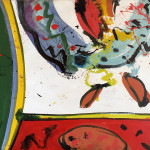Biography
Alan Davie ( 1920 – 2014) was a Scottish painter and musician. He was born in Grangemouth in 1920and studied at Edinburgh College of Art in the late 1930s. An early exhibition of his work came through the Society of Scottish Artists.
After the Second World War, Davie played tenor saxophone in the Tommy Sampson Orchestra, which was based in Edinburgh but broadcast and toured in Europe. Davie travelled widely and in Venice became influenced by other painters of the period, such as Paul Klee, Jackson Pollock and Joan Miró, as well as by a wide range of cultural symbols. In particular, his painting style owes much to his affinity with Zen. Having read Eugen Herrigel’s book Zen in the Art of Archery (1953) he assimilated the spontaneity which Zen emphasises. Declaring that the spiritual path is incompatible with planning ahead, he has attempted to paint as automatically as possible, which is intended to bring forth elements of his unconscious. In this, he shares a vision with surrealist painters such as Miró, and he has also been fascinated by the work of psychoanalyst Carl Jung.
Like Pollock, many of Davie’s works have been executed by standing above the painting, which is laid on the ground. He added layers of paint until sometimes the original painting has been covered over many times. Despite the speed at which he worked (he usually had several paintings on the go at once), however, he was adamant that his images are not pure abstraction, but all have significance as symbols.Championing the primitive, he saw the role of the artist as akin to that of the shaman, and remarked upon how disparate cultures have adopted common symbols in their visual languages.
In addition to painting, whether on canvas or paper (he has stated that he prefers to work on paper), Davie has produced several screenprints. He found a public for his work on the continent and in America some time before the British art public could reconcile itself to his mixture of ancient and newly invented of symbols and his explosive brushwork. His paintings appear at once apocalyptic and triumphant. In his lectures Davie stressed the importance of improvisation as his chosen method. His stance was that of an inspired soothsayer resisting the inroads of rational civilization.
Musically, Davie also played piano, cello and bass clarinet. In the early 1970s his interest in free improvisation led into a close association with the percussionist Tony Oxley.His paintings have also inspired music by others, notably the bassist and composer Barry Guy.
Davie designed the jacket for RW Feachem’s book Prehistoric Scotland, published by Batsford in 1963. The design was based upon motifs found on Pictish symbol stones. He died aged 93 in Hertfordshire, England on 5 April 2014.

 Say A Prayer For Me Oh Delicious One
Say A Prayer For Me Oh Delicious One